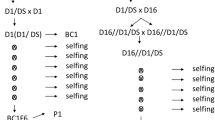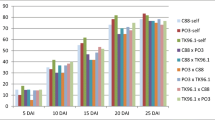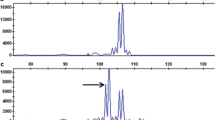Abstract
Inheritance of resistance to Phytophthora infestans in the diploid Mexican species S. bulbocastanum and S. verrucosum appears to be quantitative. In these species there seems to be no clear distinction between a hypersensitive reaction to infection and one indicating a high degree of partial resistance. Sibbing or selfing apparently improves the degree of resistance in the progeny over that of the parents. S. verrucosum, a self-compatible species which shows little or no inbreeding depression after selfing, has especial advantages as a genetic tool and as a source of blight resistance, over S. bulbocastanum and other diploids.
Similar content being viewed by others
References
Black, W., 1960. Races of Phytophthora infestans and resistance problems in potatoes. Scottish Plant Breeding Station Rept.: 29–38.
Black, W. and Gallegly, M. E., 1957. Screening of Solanum species for resistance to physiologic races of Phytophthora infestans. Am Potato J. 34: 273–281.
Graham, K. M., Niederhauser, J. S. and Romero, S., 1959. Observations on races of Phytophthora infestans in Mexico during 1956–1957. Am. Potato J. 36: 196–203.
Graham, K. M., Niederhauser, J. S. and Servin, L., 1959. Studies on fertility and late blight resistance in Solanum bulbocastanum Dun. in Mexico. Can. J. Botany 37: 41–49.
Hougas, R. W. and Peloquin, S. J., 1958. The potential of potato haploids in breeding and genetic research. Am. Potato J. 35: 701–707.
Hougas, R. W. and Peloquin, S. J., 1960. Crossability of Solanum tuberosum haploids with diploid Solanum species. Eur. Potato J. 3: 325–329.
Niederhauser, J. S. and Mills, W. R., 1953. Resistance of Solanum species to Phytophthora infestans in Mexico. Phytopathology 43: 456–457.
Spicer, P. B. and Dionne, L. A., 1961. Use of gibberellin to hasten germination of Solanum seed. Nature 189: 327–328.
Thurston, H. D., Heidrick, L. E. and Guzman, J., 1962. Partial resistance to Phytophthora infestans (Mont.) de Bary within the Coleccion Central Colombiana. Am. Potato J. 39: 63–69.
Toxopeus, H. J., 1958. Note on the variation in expression of hypersensitivity to Phytophthora infestans in potato seedlings. Euphytica 7: 38–40.
Toxopeus, H. J., 1959. Notes on the inheritance of field resistance of the foliage of Solanum tuberosum to Phytophthora infestans. Euphytica 8: 117–124.
Toxopeus, H. J., 1960. Studies on the resistance of tuber-bearing Solanaceae from Mexico to Phytophthora infestans. Euphytica 9: 39–56.
Additional information
Contribution No. 119, Canada Dept. of Agriculture Research Station, Fredericton, New Brunswick, Canada
Rights and permissions
About this article
Cite this article
Graham, K.M. Inheritance of resistance to Phytophthora infestans in two diploid Mexican solanum species. Euphytica 12, 35–40 (1963). https://doi.org/10.1007/BF00033591
Received:
Issue Date:
DOI: https://doi.org/10.1007/BF00033591




